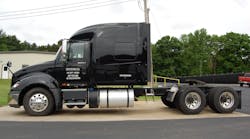Truck and engine manufacturer Navistar said it plans to begin offering over-the-air (OTA) re-programming of engine control modules (ECMs) for its N9, N10 and N13 proprietary engines in early 2016 – a service that’s been the longtime goal of many OEMs within the commercial vehicle industry.
“Over-the-air reprogramming will revolutionize the way our customers’ trucks are serviced and maintained,” noted Bill Kozek, president of Navistar Truck and Parts, in a statement. “This … is paving the way for future advancements that will drive improvements in vehicle uptime and real-world, bottom-line results for our customers.”
Dr. Steve Charlton, the now-retired VP and chief technology officer for the engine business at Cummins Inc., noted two years ago that such “on the fly” reprogramming should at some point become no more difficult than downloading digital music files.
“There’s already a broadcast of public information from today’s engine control modules of public data such as throttle and torque,” he explained during a presentation at the Mid American Trucking Show back in 2013. “But then there’s private data we can extract that enriches that public data and turns it into information.”
That detailed information can then be crafted into precise engine calibrations truck owners can tap into to improve whatever operating characteristics of their vehicles they desire, Charlton said at the time, be it for better fuel economy or better performance.
“We expect users will be able to download and apply calibrations just like the way you download and use songs from iTunes,” he noted. “We see this as a huge enabler going forward."
Navistar expects similar benefits from its “OTA” offering, which will allow customers to reprogram their ECMs via a secure Wi-Fi connection.
Mike Cerilli, GM for Navistar’s connected vehicle business division, noted that Navistar has wrapped up its initial OTA testing and next is planning customer fleet tests this fall, with the system expected to be available for 2017 model International-branded trucks equipped with N9, N10, and N13 engines early next year.
“OTA lays the groundwork for a pipeline of connected vehicle services such as partner engine and component calibration updates, body control module updates and future cellular capabilities,” Cerilli said in a statement. “These and future advancements will provide improved customer uptime, fuel efficiency and other benefits that will drive added value for customers.”



